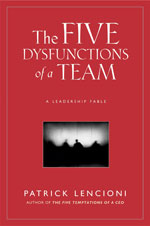 During a recent training presentation for new hires, the speaker asked the sales reps how much they believed they would sell of a particular new product, and he also challenged each one of them to write down the figure he or she had in mind. As I scanned the room to see who would actually write down a number, I was amazed to see that not one person did.
During a recent training presentation for new hires, the speaker asked the sales reps how much they believed they would sell of a particular new product, and he also challenged each one of them to write down the figure he or she had in mind. As I scanned the room to see who would actually write down a number, I was amazed to see that not one person did.
Why do so many of us want success, and yet most of us do not take a fraction of a moment to write down our end goals? Direction and goals are crucially important—if we do not know where we want to go, the chances are high that we will either not get there at all, or we will end up where we do not want to be.
I recently learned about the famous American female swimmer from the 1950s, Florence Chadwick, and her pursuit of multiple world records. I want to share her story to help you understand the importance of setting visible goals.
Chadwick’s biggest contribution to swimming occurred at age 32. On August 8, 1950, she crossed the English Channel in just over 13 hours, a victory which broke the current world record. One year later, Chadwick crossed the English Channel again, this time going in the opposite direction—from England to France. She completed this feat in slightly more than 16 hours, setting yet another record by becoming the first woman to swim the English Channel in both directions.
Having tasted success, Chadwick made another record-breaking attempt in July of 1952. She intended to become the first woman to swim the 26-mile channel from Catalina Island to the California coast.
Chadwick trained for the waves, the bone chilling waters, and even the sharks; she was ready and determined to cross after all her planning and training. However, one thing missing from her preparation was a plan of action for foggy weather.
On this particular day, the fog was so thick that she only had a few feet of visibility. After 15 hours, the conditions of the frigid water took their toll, and her muscles screamed in pain as they began to cramp.
Her support crew in the nearby boat kept telling her that the shoreline was close. They encouraged her and pleaded with her to keep going, yet she could no longer continue and gave up as the crew brought her aboard. She later realized that she had completed 25 of the 26 miles and was only one mile from the shore when she quit swimming.
Later she said, “I’m not excusing myself, but if I could have seen the land I might have made it. I lost sight of my goal. I’m not sure I ever had it firmly in mind.”1
It was not the cold, fear, or exhaustion that caused Florence Chadwick to fail—it was the fog. Even though her crew was telling her that the shoreline was just ahead, she just could not see it.
Chadwick learned a very important lesson, which she put into play two months later when she tried the same swim again, and this time the outcome was different. The same thick fog rolled in, but she made it to the shore, reporting that she kept a mental image of the shoreline in her mind as she swam.
There are two things we can learn from Chadwick’s experience: first, you must set your goals, work your goals, visualize your goals by putting them on paper, and relentlessly pursue your goals.
Second, even if you have tasted success, do not stop visualizing your goals—keep them in front of you, because you never know when fog (a challenge or hurdle) might come your way! If you keep those goals at the forefront of your mind, you will then have a far, far better chance of reaching them.

















